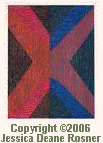|
Table of Contents Fours that I've adopted or adapted:
Fours with a striking likeness to mine: Fours involving some likeness to mine: |
More-or-less different fours:
|
(First posted April 26, 2014)
The pluralist philosopher Walter Watson in his book The Architectonics of Meaning: Foundations of the New Pluralism (SUNY, 1985) argues that four 'archic' variables are necessary and sufficient to account for the plural views in philosophy. The publisher's description:
The Architectonics of Meaning is a lucid demonstration of the purposes, methods, and implications of philosophical semantics that both supports and builds on Richard McKeon's and other noted pluralists' convictions that multiple philosophical approaches are viable. Watson ingeniously explores ways to systematize these approaches, and the result is a well-structured instrument for understanding texts. This book exemplifies both general and particular aspects of systematic pluralism, reorienting our understanding of the realms of knowing, doing, and making.
I don't have the book but have perused passages via Google Books and have read the review by George B. Pepper. Watson was brought to my attention in messages from a Tetrast reader. Watson is a pluralist, and holds with the "reciprocal priority" of various archic choices, although he also holds that there is a progression of archic profiles. There are 256 possible combinations of the values of the archic variables, and 256 squared, equaling 65,536, possible combinations of such values as characterizing the given text and such values as characterizing the given interpreter. Some values have affinities with one another and these form archic profiles, in particular Sophistic, Democritean, Platonic, and Aristotelian.
Archic variables ↓ |
1. Sophistic archic profile |
2. Democritean archic profile |
3. Platonic archic profile |
4. Aristotelian archic profile |
|---|---|---|---|---|
| PERSPECTIVE: | Personal. | Objective (inexhaustible world, practical effects). | Diaphanic (revelatory, oracular). | Disciplinary. |
| REALITY (as signified by the text): | Existential. | Substrative (under the surface). | Noumenal (transcendent). | Essential (generic traits). |
| METHOD: | Agonistic. | Logistic. | Dialectic. | Problematic (generic/specific or essential/accidental features). |
| PRINCIPLE (purpose that makes the text function): | Creative. | Elemental (persistent). | Comprehensive (universal rational order). | Reflexive (noetic self-completion). |
Watson correlates the four archic profiles with Aristotle's four causes, as shown in the table below. Next, there is some likeness between, on one hand, the archic profiles and, on the other hand, Aristotle's four causes as correlated to some fours of mine that I most recently discussed at "Telos, entelechy, Aristotle's Four Causes, pleasure, happiness" at The Tetrast. The likeness involving my versions of the four causes is poorest, though not quite absent, in the case of the Platonic archic profile.
| Archic profile according to Watson: → | 1. Sophistic: personal, existential, agonistic, creative. | 2. Democritean: objective, substrative, logistic, elemental. | 3. Platonic: diaphanic, noumenal, dialectic, comprehensive. | 4. Aristotelian: disciplinary, essential, problematic, reflexive. |
| Correlation with Aristotle's four causes, according to Watson (e.g., on Page 159): | 1. Efficient cause. | 2. Matter. | 3. Form. | 4. End, final cause. |
| MORE-OR-LESS correlated Aristotelian cause & related ideas... (as I see them): | 1. Efficient cause, impetus. —Motion, forces. —Decision processes. | 2. Matter, means. —Matter, (internal) resources. —Stochastic processes. | 3. End, final cause, telos, as culmination. —Energy, life. —Communication processes. | 4. Form as structure & as entelechy. —Structure, mind. —Inference processes. |
| ...and power of the psyche: | 1. Will, conation. | 2. Ability, competence. | 3. Affectivity. | 4. Cognition. |
| ...and side of the psyche's life: | 1. Strivings, dedications. | 2. Practices, skills. | 3. Valuings, devotions. | 4. Recognizings, knowledges. |
| ...and psyche's interbehavior: | 1. Conflict, competition, rivalry, dispute. | 2. Cooperation, tolerance, etc. | 3. Communing, valuational community. | 4. Checks & balances. |
| ...and (with distinctions similar yet ortho- gonal to those among the interbehaviors) the psyche's behavior as aiming for change brought to or drawn from objects: | 1. Potition, appropriation, adoption, taking charge. | 2. Production, processing, adaptation. | 3. Consumption, expression. | 4. Rumination, digestion, assimilation. |
Watson correlates not the final cause, but the formal cause, with the Platonic archic profile; and not the formal cause, but the final cause, with the Aristotelian archic profile. Indeed Plato is the philosopher of the Ideas, a.k.a. the Forms — form as idea, eidos, species, which words originally meant look, appearance, view, and have never strongly connoted form in the sense of structure.
. . . . |


